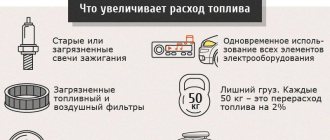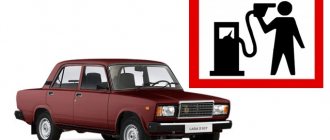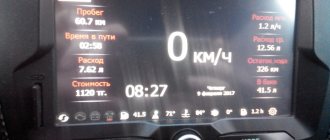Fuel consumption at idle
According to the definition from the dictionary, the operating mode of the device when there is no load is called idle. For a car, idling means the car is stationary but the engine is running. For example, when boarding and disembarking passengers. Naturally, a running engine consumes fuel. What will be the fuel consumption at idle?
Engine operation always starts in idle mode (idle speed). This mode allows you to evaluate the quality of the motor. The main criterion for its assessment will be fuel consumption at idle. In this mode, the energy obtained from fuel combustion is spent only on the engine itself.
It must be admitted that estimating the fuel consumption of cars is a rather difficult task. There are too many factors influencing this action. For example, what type of engine? Carburetor or injection? With different engines, fuel consumption and the factors influencing it will differ.
When asked how to calculate fuel consumption, we can advise using one of two practical methods. In the first case, you need to drive until the fuel tank is completely empty, as a result of which the car stalls. Then you need to pour a known amount of gasoline, for example, pour the contents from a 10-liter canister into the tank. It is necessary to drive on this amount of gasoline until the engine stalls again. And after that, dividing 10 liters by the number of kilometers traveled, we get the desired value.
Another method is to fill the tank with fuel up to the cap and drive as far as possible after this refueling, taking into account the mileage traveled. Then add gasoline from a measuring container, for example, from a canister, to the same level as at the beginning of the trip, i.e. to the traffic jam. And determine how many liters of fuel had to be added. This amount that had to be topped up must be divided by the kilometers traveled - you get the gas mileage.
However, the results obtained should be assessed correctly. In many ways, they relate not only to the operation of the engine, but also to various associated effects. So, if the car is new, then its engine is unused and during the first ten thousand kilometers it will undergo a break-in. The car engine parts will grind against each other, and the engine will consume more fuel. This is normal and nothing to worry about.
The condition of the road surface also affects fuel consumption. When driving on dry asphalt this will be one value, when driving on fresh snow it will be much larger.
Therefore, it is best to evaluate the engine while idling. If the speed is idle. more than 1000, this indicates some kind of malfunction or malfunction in the car. It is necessary to look for and eliminate the defect or adjust the engine. Another indicator that allows you to evaluate engine performance is fuel consumption at idle.
It is very difficult to determine such consumption, because... there is nothing to compare with. It is estimated in practice, usually in liters per hour; for Zhiguli, the practically obtained value is about one liter per hour.
It is best to evaluate fuel consumption at idle and the performance of the engine itself, as noted above, by idle speed. Albeit indirectly, but objectively. With a normally running engine and serviceable machine components and sensors, the value should be 800-1000 rpm. Deviations from this value will indicate a malfunction in the vehicle.
The presented material examines the no-load operating mode of a car engine. An operating mode called idle is defined and described. The definition and methods for measuring fuel consumption both in normal driving mode and in idling mode are given.
Fuel consumption in different modes of the Lada Vesta car
So, let's look at how much gasoline the modern products of the Volzhsky Automobile Plant consume using a specific example. We are talking about Lada Vesta - a car that has become very popular on the Russian market. It should be noted right away that this car can have one of two possible types of gearbox - manual or robotic.
So, let's first see what numbers the manufacturer himself gives. In particular, for a Lada Vesta with a 1.6-liter engine with a capacity of 106 “horses” and a robotic gearbox, it consumes per 100 kilometers:
- in the city - 8.9 liters;
- on the highway - 5.3;
- mixed cycle.
Vesta has slightly different numbers with mechanics. In particular, a car in this configuration consumes the following amount of fuel per 100 kilometers:
- in the city - 9.3 liters;
- on the highway - 5.5;
- mixed cycle – 6.9.
As you can see, the machine is economical in all three modes. Moreover, the Vesta robot is more economical than, for example, the Granta automatic transmission - in the combined cycle, cars consume 6.6 and 7.6 liters of fuel, respectively. It should be noted that the instruction manual provides slightly different, generalized figures. Let's look at them in more detail. In particular, according to the operating manual, the average fuel consumption of Vesta per 100 kilometers is:
- in the city - 10.13 liters;
- on the highway – 6;
- mixed cycle – 7.51.
However, in practice, the gasoline consumption figures declared by the manufacturer are, as a rule, 20 percent lower than the real ones. The thing is that the plant takes measurements in special laboratories, while the car itself is in conditions different from normal road conditions. Many people know about this, so the numbers indicated by the manufacturer are not simply ignored - they are simply perceived with a certain degree of skepticism. Generally speaking, the actual consumption of Vesta, depending on the installed gearbox, ranges from 8 to 10 liters - this will be the norm.
This indicator is also influenced by a number of other factors. In particular, engine malfunctions or problems with the fuel system have a negative impact on fuel consumption. Increases the appetite of the car and electrical equipment - headlights, air conditioning, sound system with amplifier. Reduced tire pressure, as well as the use of wheels wider than those recommended by the manufacturer, increases consumption by 4 percent. Driving on an engine that is not warmed up to operating temperature increases the car's appetite even more. Practice shows that consumption increases by 12 percent.
Fuel consumption increases in winter. Firstly, the engine takes longer to warm up, and it cools down much faster than in summer
In addition, due to the slippery road surface, you have to drive more carefully than on dry asphalt. We add here a working heater and turned on headlights, and we draw a completely logical conclusion - in winter, fuel consumption increases due to several factors at once
How to reset the average fuel consumption on a Lada Vesta?
So, you have excluded the factors influencing the increased fuel consumption of Vesta. How to determine what the consumption is now? It is necessary to reset the consumption indicators of Vesta’s on-board computer, but this is not as simple as, for example, the ninth family of VAZs.
With the ignition on, press both buttons of the left switch twice simultaneously. In the menu, according to the speedometer entry, select average consumption. Now hold the top button for about 3 seconds. As soon as the flow rate flashes, release it, then press it again until it stops flashing. Press the bottom button to exit the menu.
Reducing fuel consumption on a Lada Vesta saves money and extends the life of your engine and transmission. The key to normal consumption is careful driving and careful handling, and this has never harmed anyone.
Reasons for high fuel consumption?
- Winter time . In winter, a lot of time is spent on warming up the car itself, hence the increased consumption.
- Gasoline quality . An important factor affecting fuel consumption. In some regions it is difficult to find real 95 gasoline.
- AI-92 instead of AI-95 . The instruction manual states that Vesta digests 92nd gasoline calmly, but it has long been proven that consumption on 95th is less than on 92nd. Power tests of the 21129 motor were also carried out on the stand. When using AI-95, the engine power is 106.1 hp, when using AI-92 the power is 102 hp. (Which gasoline should I fill up with? 92 or 95?)
- Riding mode . Everything is clear here: if you are constantly stuck in traffic jams or the engine simply idles for a long time in a standing mode - whatever one may say, the Vesta’s on-board computer will show the consumption that you will not be happy about.
- Aggressive driving style . Constant acceleration and braking.
- Additional work equipment : music, amplifiers and other energy consumers put a load on the generator, which, in turn, puts a load on the motor itself. This also applies to the air conditioning compressor, which adds about 1 liter per hour to the flow rate.
- Malfunction of the engine power supply system ( High fuel consumption reasons ) . Home page
What kind of gasoline should be poured into the Lada Largus, choose between 92 and 95
Many Lada Largus owners wondered what kind of gasoline to pour into their favorite “iron horse”.
You can often come across this question on various automotive forums, but no one can give a clear answer. Let's try to consider and come to a conclusion, what kind of gasoline is needed for this car?
Recommendations from the AvtoVAZ plant
Standard gas pump at a gas station
Which of these will we choose for Largus?
According to the service book and manufacturer's recommendations, Largus must be filled with fuel with a medium or high octane number. So, the question arises, what kind of gasoline should be poured into the tank - AI-92, AI-95, AI-98, or the Premium and Euro varieties? In the same manual about the fuel system it is written that it is not lower than AI-95. This is due precisely to the effect on the fuel system, which better perceives this particular marking.
Renault engine manufacturer's recommendations
The factory recommendations are duplicated on the gas tank flap cover (only 95 and 98)
Lada Largus fuel filler flap indicating the type of gasoline
Since the Largus has a Renault engine, you should listen to this manufacturer when choosing gasoline.
An exact definition was found in the service book for the K4M and K7J engines. The fuel system must be filled with gasoline marked at least A-95E.
Gasoline consumption on the dashboard of Lada Largus
To reduce consumption, the manufacturer recommends using only 92 gasoline.
This fuel is designated AI-95 Euro on the domestic market.
Expert recommendations
In 2014, this car was tested on different types of fuel. Three cars with the same characteristics, into which AI-92, AI-95 and AI-98 were poured. Each of them was tested for different indicators.
When using AI-98, the engine overheated too much and the cooling fan could not cope. Therefore, experts noted that this brand of fuel is not very suitable for use in Lada cars.
When using AI-95, there was a noticeable increase in dynamics and a drop in consumption compared to AI-92. Thus, experts noted that the ideal option is to use this particular brand of fuel.
Motorists' experience
Experience says it's 95!
Based on the experience of motorists, we can say that AI-95 becomes the optimal option for use. After switching to this brand from AI-92, the dynamics noticeably increased, and the consumption decreased by almost 25%, which cannot but please the owners.
Also, auto mechanics note that when using AI-95, there is less deposits on the walls of the combustion chambers, and the fuel system becomes clogged and fails much less often. Therefore, it is recommended to fill Largus with this type of gasoline.
Economical driving
So is it necessary to turn off the engine when idle?
So, the easiest way to save fuel is to turn off the engine while it is running. If you think that we are talking about some drops, then you are mistaken. It is not without reason that many modern cars are now equipped with a system called “start-stop”, which turns off part or all of the cylinders while the car waits in traffic jams or at city traffic lights. However, not everyone’s car can boast of such a technical innovation. And then the car enthusiast notes with surprise how the consumption of his car has increased and asks himself the question why this happened...
That is why experienced drivers who want to save on maintenance turn off the engine in all cases if they have to stand idle for more than 10 seconds. This is such an average value at which it is advisable to wonder whether the fuel is simply flying out of the gas tank into the pipe?! This is especially true in cases where the vehicle has stopped in a safe place, without creating any interference with other traffic participants or emergency situations.
Always use gasoline with the correct octane rating.
It goes without saying that you cannot use gasoline mixed with diesel fuel: after that you will have to change the oil. Filling the tank with fuel of a higher quality than recommended by the manufacturer has no effect.
The use of fuel with a lower octane number can cause two negative phenomena: self-ignition, which occurs before the working mixture is ignited by an electric spark, and detonation, which ultimately leads to a decrease in engine power and increased wear of valves, their seats, pistons, piston rings and spark plugs, not to mention simply increasing gas mileage.
Increased detonation is indicated by frequent engine knocking, similar to drumming. Detonation can lead to failure of the main and connecting rod bearings and piston pins. Only in some modern cars does the coordination of engine operation with fuel brand occur automatically; in others, it is necessary to change the ignition characteristics in accordance with changes in the fuel brand. The ignition in some cars can be adjusted by recoding the plug in the engine compartment to another characteristic (from 98 to 95 and from 95 to 93).
The main reasons for increased fuel consumption
- If we ignore possible technical faults, there are not many reasons for increased fuel consumption. For example, driving with headlights constantly on, although it increases safety, also leads to a 5-10 percent excess consumption of gasoline.
- The same applies to the insufficient quality of the gearbox. If it does not “pull” at the required speed, then this may provide a slight increase in the amount of gasoline consumed.
- Do not try to buy gasoline with too low an octane rating. Such savings will immediately result in increased costs up to two times (!). And we’re not even talking about the wear rate of individual engine parts and the fuel supply system. If you use low-quality gasoline, you will have to drain the gasoline from the tank, and this cannot be done on a Lada Granta using old-fashioned methods!
- A non-obvious reason may be poor alignment of the wheel alignment system. This needs to be done twice a year, when you change your shoes to new tires. Problems may also arise when choosing a “sports” type of camber.
- Another reason is incorrect gaps set in the spark plugs.
However, as the drivers themselves say, a lot depends on the style of driving. It’s difficult to expect “factory” fuel consumption figures from someone who starts abruptly and stops just as abruptly. You can curb the car’s appetite only when it feels smooth, picks up speed carefully, and maintains it at high speeds for a long time, but with a minimum number of engine revolutions. Of course, this is difficult to achieve, especially in conditions of poor quality road surfaces, but you still need to try.
Owners about fuel consumption
It is not difficult to find a review of the Lada Vesta, because many have purchased this worthy vehicle. Ivan from Belgorod claims that the car’s efficiency is quite economical, especially in comparison with analogues in this class. Over four years of use, the Lada Vesta with a manual transmission, with a consumption of 1.6 liters, has an average gasoline consumption per 100 km. in the city -10 l. and on the highway - 7. True, when filling in 92nd gasoline, consumption indicators increase by 1 unit.
Mikhail from Belarus has been using Lada Vesta recently, since 2021, and has managed to drive 14,000 km. Average fuel consumption is 9.7 liters per 100 km, using 95 gasoline. The owner is satisfied with the cost-effectiveness, and he states that in comparison with his previous car of a similar class, this model wins in all respects.
Evgeniy, a resident of the city of Kursk, has been the owner of Lada Vesta since July 2021. During its service life, no serious comments were identified regarding efficiency, taking into account the manner of movement. Evgeniy loves fast driving with sharp turns. Consumption in an urban environment - 10 liters. On the highway - 8 liters per 100 km. roads.
Andrey from Moscow purchased a Lada Vesta in February 2021. The model has an engine capacity of 1.6 liters and a power of 106 horsepower. Most of the time the user moves around the city, sometimes he goes on the highway. At the beginning of operation, the car consumed 12 liters. After a while, the motor “broke in”, taking on the optimal consumption rate. Consumption has decreased and is now 11 liters. in an urban environment, 7l. In the countryside.
With engine 1.8 122 hp
Lada Vesta with a VAZ 21179 engine went on sale in the fall of 2021. This power unit develops a power of 122 horsepower and has decent torque. Its cylinder capacity was increased to 1800 cm3, which gave an increase in power. Almost all Lada Vesta models with this power unit are equipped with a robotic gearbox.
The actual gasoline consumption of Vesta Cross with such a box is low. To drive on city streets you will need 9.3 l/100 km; on highways it is significantly less, about 6 liters, in the combined cycle just over 7 liters.
Gasoline consumption and the cost of operating a car with manual gear selection are slightly higher. Only about 500 cars were produced with this box; this configuration was called “Anniversary Lux”. The average fuel consumption rate for this configuration is 7.5 liters when covering 100 km. Buyers order this vehicle configuration from the manufacturer.
Real consumption according to reviews
- Nikolay, Petrozavodsk. I saw this car in an advertisement and fell in love immediately and completely. I picked it up at a car dealership in Moscow and delivered it home myself. I don’t regret the choice, I have no complaints so far. I only fill the tank with 95 octane gasoline, as specified in the vehicle's owner's manual. I drive the car carefully, so the real fuel consumption of the Lada Vesta is very moderate. In cold weather, it increases somewhat due to the need to warm up the engine, but the average is approximately 8 liters per hundred kilometers of travel.
- Stepan, Bryansk. Before buying Vesta, I also used a copy from Togliatti, it was a Priora. If we compare these two models, I like the Lada Vesta better. The car turned out to be beautiful, the assembly is of high quality, I can’t even believe that the car was made domestically. The engine turns perfectly, provides good dynamics of the car with moderate consumption of 100 kilometers on AI 95 gasoline, about 8.5 liters are required. The actual fuel consumption for this model does not coincide slightly with the stated data from the factory, probably due to the way the car is driven.
- Sergey Moscow region. I used the VAZ classic VAZ 2107 for a long period of time, but the time has come to replace it. I didn’t have to hesitate for long with the choice; I settled on the Lada Vesta. I bought it at a car dealership, I have a basic AvtoVAZ standard, which I am very pleased with. Today, the total mileage of my “swallow” is just over 30 thousand km on a variety of roads. Most of the time you have to travel in the city where approximately 12 liters per hundred km are burned. The capacity of the car is good, so we often go on vacation with our family. In this case, the AMT consumption is reduced to 6 liters per hundred km.
What is the consumption of the Lada Vesta according to AvtoVAZ?
The official AvtoVAZ website gives us the following figures.
Fuel consumption with a 1.6 liter engine 21129 106 hp. with French manual transmission is:
- urban mode 9.2 l
- mixed mode 7.1 l
- highway mode 5.9 l
Fuel consumption with 1.6l engine 106hp + manual 21807
- urban mode - 9.5
- mixed mode - 6.3
- highway mode - 7.5
Fuel consumption with a 1.6L 106hp engine + robotic gearbox is:
- urban mode 9.1 l
- mixed mode 6.7 l
- mode highway 5.4 l
Fuel consumption with 1.8l engine 21179 122l.s + Robot
- urban mode - 9.2
- mixed mode - 6.1
- highway mode - 7.3
Fuel consumption with Nissan engine 1.6l 110hp HR16DE (H4M)
- city mode - not available
- mixed mode - not available
- track mode - not available
Since 1.8 liter engines and Nissan engines are not yet installed on Vesta, it is difficult to judge fuel consumption. But they will all be approximately the same.
Please note that Vesta’s robot is slightly more economical than French mechanics. This is due to the settings and smooth operation, in a word, the robot is configured for an economical, quiet ride, where over-throttle is eliminated during shifting as on a mechanic, and the clutch drops smoothly.
But the instruction manual for the Lada Vesta gives slightly different numbers, more realistic, with the note “starting on a cold engine.”
- urban mode 10 l
- mixed mode 7.5 l
- mode highway 6 l
Factors that increase consumption
- curb weight of the vehicle;
- engine volume;
- type of pre-installed gearbox;
- size, height, width of tires;
- style and manner of management;
- condition of machine components;
- frequency of use of equipment in the car;
- temperature regime overboard.
Conclusion
Regardless of the type of preinstalled transmission, it is quite possible to reduce the “appetite” of the motor if you adhere to the described recommendations.
To reduce fuel consumption as much as possible, fill with AI-95 gasoline. In suburban mode, do not exceed the average speed of 90 - 95 km/h. The maximum permissible threshold is 100 km/h.
There is an opinion that filling third-party chemical additives helps reduce the “appetite” of the engine, gives power and acceleration dynamics. Service station fuel workers are wary of such statements, as they believe that this is more a marketing ploy than real savings. Of course, the final decision is up to the owner of the technical device.
Reviews of real fuel consumption of Lada Vesta Cross
Leonid:
“Vesta Cross SV, 1.6M, mileage 17 thousand km.
The average consumption according to the BC is 7.3 liters, mainly on the highway with traffic jams (those who drive like this know), the driving style is frisky, I always keep the revs at 3k/min, otherwise the car “doesn’t go/doesn’t pull.” One thing is clear that the car is gluttonous... I talked with the owner of the Hyundai Creta, it has a 1.6M engine, consumption is 5-7l, while the Lada St. Cross fuel consumption is 7-9l.”
Ilya:
“Mileage 26,000 km
. Real fuel consumption of St. Cross 15.2 city! With warm-ups and frequent idling.”
Evgeniy:
“Vesta SV Cross 1.8 manual.
Mileage 8000km. The actual consumption in the combined cycle on the screen is from 10 to 11 liters, compared by mileage from refueling to refueling - the same. Most of the time I drive around the village, the roads are bad. On the highway I drive an average of 140 km/h. When driving 100-120 it shows 6.5-7 liters. I accelerated to 180 and the consumption showed 19.7 liters. »
Real fuel consumption from Vesta Cross owners
Car owners answer:
“Before purchasing Vesta in the Cross version, I had a used Volkswagen Golf, it consumed a little more fuel, in contrast, a new car has a liter or a liter and a half less, although I don’t change my routes and the refueling is the same. On average, on Vesta I travel 25–30 kilometers more with the same movement. On the highway, with steady gas, I consume approximately 5.5 - 6, and in the city approximately 7.5 - 8. And, on average, consumption is about 10 liters per 100 km. By the way, the car does not require sharp gas; it is quite maneuverable and nimble.”
(Igor, Nizhny Novgorod)
“I recently purchased a Lada Vesta with a 1.8 engine on a robot. I liked the handling and spaciousness, in terms of consumption: the car in the city is about 11 liters, and on the highway from 7 to 9.”
(Andrey, St. Petersburg)
“I have a mechanical Vesta SW Cross with 106 hp. Outside the city on the highway it’s about 7-7.5 liters, in the city about 10.”
(Kirill. Novokuznetsk)
Video review of consumption from one of the owners of Vesta Cross with a 1.8 engine:
Fuel consumption of Lada Vesta SV
In addition to the basic Lada Vesta itself, this car has several more modifications. Of course, their fuel consumption will also differ. Lada Vesta SV fuel consumption:
- the norm for SV is 1.6 – 5.7-9.2 l;
- real consumption for SV 1.6 is 6.5-10 l;
- the norm for SV is 1.8 – 6-10 l;
- real consumption for SV 1.8 is 7-11 liters.
There is also a Lada Vesta SV Cross. According to the standard, its fuel consumption is 7.4-10.7 liters, but in fact – 8-11.5 liters. As for the Cross Lux model, it has the highest consumption compared to others. The norm is 8-11 liters, and real consumption is 8-11.5 liters.
Factors that increase fuel consumption
All the above figures, both according to standards and in fact, are calculated based on the most favorable operating conditions of the vehicle. However, there are also factors that influence fuel consumption in one way or another.
These include:
- Driving style. We are talking about too “jerky” driving. Sharp braking and rapid acceleration increase gasoline consumption. Conversely, a restrained style, with smooth braking and a gradual increase in speed, reduces consumption.
- Gearbox. Why is consumption usually lower with an automatic? This also has to do with driving style. With a manual transmission, the driver may change gears too late, resulting in higher revs, whereas with an automatic transmission everything happens automatically.
- Poor quality fuels and lubricants. With gasoline, everything is clear - the worse it is, the more it is required to ensure the normal functioning of the engine. However, fuel consumption is also affected by the quality of lubricants: engine oil, transmission fluid. If their quality is low, the friction of parts increases, their wear increases, and as a result, the engine requires more gasoline. Deposits in the system, which impair heat transfer, also indirectly affect consumption.
- Breakdowns and incorrect operation of the internal combustion engine. As mentioned above, engine wear increases fuel consumption. This is also affected by leaks, clogged valves and filters with deposits and other minor and major malfunctions.
- Operation of electrical appliances. Any additional equipment operating in the cabin increases fuel consumption.
Fuel consumption indicators for different engines: norm and real data
How much the machine should “eat” according to the norm is stated in the technical documents. But in fact, the real numbers are always different. This difference is made up of the following factors:
- vehicle weight;
- engine capacity;
- driving style;
- driving conditions: highway or city;
- drive unit.
It is important to note that the passport standard is practically unattainable. A positive option for any car is when the car consumes no more than 10-15% more than what is indicated in the documentation per hundred kilometers.
Lada Vesta VAZ-21129 (1.6)
The initial and most popular type of engine for the Lada Vesta is a 1.6 liter 106 horsepower engine with 10 valves. There are two options for such models: they can be equipped with both mechanics and automatic transmission. This will significantly affect fuel costs. The official website contains standards that have been tested in laboratory conditions and are not related to operational figures. In practice, these figures are always slightly higher.
With engine 1.6 manual
The consumption standards for a manual gearbox in the car's passport are as follows:
- for driving in urban areas – 9.4 liters per hundred km;
- for driving on a flat country road – 5.7 liters for the same distance;
- when mixing driving cycles - 6.8 liters.
In reality, indicators for mechanics:
- driving in urban areas - 10.4 liters;
- on a country road - 6.4 l;
- when mixing driving types - 8.1 liters.
If the driver is accustomed to smooth control, then the fuel cost parameters will always be slightly lower than when driving with constant braking and a sharp start.
With engine 1.6 Robot
Costs, both standard and actual, are slightly lower with automation. Passport indicators:
- urban conditions - 8.9 liters per 100 km;
- road outside the city – 5.3;
- when mixed - 6.6 l.
Real figures: for the city 9.9 liters, for the highway - 6.2 liters, and with mixed driving - 7.5 liters.
This is with good driving, without taking into account additional factors. On average, Lada Vesta “eats” 8–10 liters per 100 km with a 1.6 engine.
Owner reviews about fuel consumption of Lada Vesta 1.6 106
Lada Vesta VAZ-21179 (1.8)
The VAZ-21179 engine was released recently, and it powers the station wagon. Engine indicators:
- 1.8 liters;
- power parameters – 122.5 horsepower;
- 4 cylinders;
- compression level – 9.
When moving around the city, the maximum consumption for such an engine is 11 liters per hundred km. But the details also depend on the gearbox.
With 1.8 manual engine
Indicators for mechanics according to the passport:
- in the city - 11 liters;
- outside the city – 6 l;
- mixed driving – 7 l.
In reality, a manual with such an engine consumes from 8–12 liters, depending on driving conditions.
With engine 1.8 Robot
The machine spends less:
- in the city - 10 l;
- outside urban conditions – 5.5;
- mixed driving – 6.5.
In fact, the figures range from 7 to 11 liters per 100 km.
Owner reviews about fuel consumption of Lada Vesta 1.8
Lada Vesta HR16DE (1.6)
The foreign version of the 1.6 liter engine has 117 horses. With the same volume as the VAZ-21129, the foreign engine has more power. They are not adapted for automatic, there is only a mechanical option. Standard fuel consumption indicators for this engine:
- in the city - 8 liters per 100 km;
- on the highway - 5 liters per 100 km;
- with mixed driving – 6 liters per 100 km.
In fact, the Lada Vesta HR16DE consumes 6–9 liters. It is permissible to refuel such a car with methane, which is much cheaper in terms of costs.
This is interesting: How to check the remaining gasoline in Renault Logan
During short stops, do not turn off the engine.
Starting the engine again is more expensive than running it at a properly adjusted idle speed. In winter, additional starting with a starter can be doubly a source of trouble.
Naturally, this driving style does not contribute to saving gasoline (with smooth driving, gasoline consumption is 10-20% lower than with a sporty driving style). A car that speeds away at a green light and then brakes hard before the next intersection also wears out the engine, clutch, tires and brakes faster. There is also an aesthetic side to the question: what does the “eight” look like, posing as a “Jaguar”?
Get used to approaching the intended stopping by coasting
without resorting braking .
Aerobatics - do not use the brakes when driving at speeds exceeding 30-40 km/h. By moving by inertia, we compensate for the energy spent on accelerating the car. During sudden braking, this energy would be spent on overcoming friction forces. The practiced skill of coasting in the city provides fuel savings of 20-25%. When driving on slippery roads, this habit also ensures safety. In a city environment, moving along the same route day after day, it is possible in practice to set the speed and method of movement that allows you to drive without stopping, reducing the speed in places of potential danger.
Comparison of consumption of 92 and 95 gasoline
Measurements carried out by car owners show that the cost of gasoline with an octane rating of 95 is 0.5-0.7 liters lower than when using A-92. The resulting difference compensates for the increased cost of A-95 grade fuel.
The advantages of using high-octane fuel are a reduced risk of detonation and increased engine power.
The disadvantages include a large number of additives in A-95 gasoline (especially for fuel supplied to gas stations of small companies), which settle on the electrodes of the spark plugs and impair the performance of the ignition system.
Lada Vesta SW 1.8 AMT, Luxe Multimedia › Logbook › Activating hidden functions via DDT4ALL
Preface.
Good afternoon to all subscribers and just visiting readers. I didn’t expect that my previous post in which I described how to activate (or deactivate) some hidden functions using an Android smartphone and an ELM327 adapter would be quite popular among readers. Now I will try to describe in detail the process of activating these same functions, plus a couple more not mentioned in an alternative way: through a laptop with Windows OS and the ELM327 adapter. Some may ask: Why a laptop and not a computer? I want to answer right away - each of you can use the type of computer that is more convenient for him. But, it is worth considering that your laptop or computer must be able to connect to the ELM327 adapter. For those who are not in the know, there are ELM327 adapters with different connection types (interfaces). The most common adapters have two wireless interfaces - Bluetooth or WiFi, as well as one wired connection type - USB. I deliberately do not consider the COM port connection interface for two reasons - it is quite difficult to find a laptop or computer with a COM port, as well as the adapter itself with an RS-232 or DB-9F connector. I would also like to note that to successfully complete all the procedures below, you need an ELM327 ver. 1.5. Alas, the adapter version 2.1 will not work, although it works quite well with the Opendiag program.
With engine 1.6 106 hp
For this vehicle model, the base model of the power unit is an engine with a displacement of 1.6 liters, which is capable of delivering approximately 106 horsepower. The “engine” is a 16-valve version of the engine running on gasoline with an octane rating of 95. It is combined with a five-speed manual transmission or automatic transmission. Gasoline consumption of Lada Vesta according to factory data for various gearbox options can be as follows.
For “mechanics”, when driving in the city you will need 9.3 liters per 100 km, in city and highway conditions a little less than 6.9 l/100 km, and when driving on the highway only 5.5 l/100 km. For the automatic transmission, the gasoline consumption data is slightly less and amounts to 8.9-6.6-5.3 l/100 km, respectively. Manufacturers claim that when installing a robotic gearbox, fuel consumption will decrease slightly. From this we can conclude that with the right approach to operating the machine, you can achieve significant savings on the “mechanics”.
The car engine develops 106 horsepower, which is quite enough for comfortable movement both on the highway and in the city. Reviews from Lada Vesta owners about actual consumption can be found very different, which indicate that it largely depends on the driving style of the car, its operating conditions, and the fuel used. Most of them indicate increased indicators compared to factory data.
Fuel consumption of Lada Vesta with different types of engines
The most important factor determining the Lada Vesta’s fuel consumption per 100 kilometers is the type of engine installed in it. The standard configuration of a car, no matter whether it is a sedan or a station wagon, consumes 7-10 liters of gasoline.
HR16 DE-H4m
This power unit, with a volume of 1.6 liters and a power of 117 horsepower, is produced by Renault. It is equipped with a manual gearbox. This is a fairly economical engine. Its real indicators compare favorably with the norms specified in the documents. So, city driving will spend 8 liters per 100 km, driving on the highway – 5 liters. Average consumption for mixed driving is 6 liters per 100 kilometers.
VAZ-21129
This engine is the most popular for the Lada Vesta. It was he who was in the original configuration of the car. Its volume is 1.6 liters and its power is 106 hp. It is equipped with both “mechanics” and “automatic”. According to the standard, a 1.6 liter engine with a manual transmission should consume 9.4 liters per 100 km in the city, 5.7 liters on the highway, 6.8 liters in mixed driving. The actual values are slightly different. These are 10.4, 6.4 and 8.1 liters, respectively. According to the standard, a 1.6 liter engine with automatic transmission should consume 8.9 liters per 100 km in the city, 5.3 liters on the highway, 6.6 liters in mixed driving. In real life, city driving will consume 9.9 liters per hundred, on the highway this parameter will be 6.2 liters, and with mixed driving 7.5 liters. An automatic transmission reduces fuel consumption. But all these figures, of course, are conditional - with a smooth ride in relatively favorable conditions. If we average the indicators, then the real fuel consumption of the Lada Vesta per 100 km with a 1.6 liter engine will be 8-10 liters.
VAZ-21179
This engine for the Lada Vesta is the most modern. Its characteristics are 1.8 l, 122.5 hp. This kind of internal combustion engine “eats” more than others installed on this car. Its maximum consumption according to the standard is 11 liters per 100 km. However, it depends on the gearbox with which the engine is equipped. With a “mechanics” the expected consumption in the city is 11 liters, in reality it can reach 12. On the highway the consumption rate is 6 liters, in fact – up to 8 liters. Thus, the average will be 8-12 liters. With an automatic transmission, consumption according to the standard ranges from 5.5 to 10 liters per hundred kilometers. In reality, this figure is from 7 to 11 liters.
About the reasons for excessive fuel consumption
The amount of fuel consumption of the Lada Vesta is directly affected by several important factors.
Among them:
- frequent acceleration in intensive mode and “aggressive” braking, which can lead to an increase in consumption;
- malfunctions in the engine and in particular in the injection system can also provoke an increase in consumption;
- turning on auxiliary comfort systems, for example, air conditioning, which will have similar consequences;
- natural factor - winter;
- air pressure inside the tires (if you need to load the car, you should take care of inflating the tires).
Owners of such a popular car as Vesta are recommended not only to be guided by the fuel consumption figures given by the manufacturer in their manual, but also to be based on the results of their own experience. Here you should also take into account the modification in terms of equipment, because a car with an automatic transmission unit, according to numerous experts, can consume slightly more fuel.
Reasons for increased fuel consumption of Lada Vesta
The cost of gasoline consumption today is taking a significant toll on your wallet. It’s rare that a Vesta owner won’t notice that gas mileage has increased. High fuel consumption often indicates a car malfunction, but this is not always the case. Let's look at the reasons for the increase in gasoline consumption following the example of the Lada Vesta Cross SV.
On the mechanics, everything depends on the driver’s experience, but even incorrect gear shifting will increase the car’s fuel consumption. The engine speed has increased, the gearbox continues to transmit torque in the previous gear, no shifting occurs, and naturally more energy and gasoline are consumed, respectively. With the right gear, at the right speed, the car would have already gone further, so the fuel is wasted.
The robot automatically changes gears; it turns out that 100 km for a manual transmission is more expensive than for a manual transmission. With a robotic gearbox, the station wagon can more easily withstand sudden accelerations and braking, which characterize city trips. On the highway there are always high gears and high speed and consumption is 1.5-2 liters lower. But the route is different - ups and downs, serpentines and a flat road. A long uphill climb puts more stress on the engine, which increases the amount of gasoline used.
Switched on energy consumers take charge from the engine and affect the amount of gasoline burned. Moreover, this applies not only to the air conditioner or subwoofer, but also to ordinary car headlights.
In winter, fuel combustion increases due to the constant inclusion of additional equipment, due to the engine warming up before driving.
Uneven tire pressure increases the load on the internal combustion engine. Tires that are too narrow or too wide can also affect fuel consumption.
Ways to save fuel
The main way to reduce fuel consumption to the level specified by the factory is to reduce the load on the engine. The driver needs to accelerate smoothly and use the vehicle's roll and engine braking mode.
When traveling on country highways, the speed should not exceed 100-110 km/h. Using an air conditioner increases the level of comfort, but the compressor requires 1 to 1.5 liters of fuel for every 100 km of travel. If the driver and passengers open the side windows, then due to increased aerodynamic resistance, consumption increases by 0.5-0.7 liters.
A drop in tire pressure negatively affects the vehicle's efficiency. A dirty air filter and towing a trailer have a negative impact.
Some owners install plastic deflectors along the door frames, which also increases fuel consumption.
The owner of the car needs to carry out routine maintenance in a timely manner with diagnostics of the electronics that control the operation of the power unit.
Do not fill the fuel tank to the top on hot days.
At a gas station you fill in cold fuel; when heated, it expands in volume (up to 5%). It is dangerous if the fuel begins to leak from the tank as it heats up. A drop of fuel is placed in the neck of the tank, and the increase in fuel reserve due to this is insignificant. We inherited the habit of drinking gasoline to capacity from earlier times, the era of “scarcity.” The filler neck of the tank in most cars is connected to an air vent tube, so if the fuel overflows, it flows out or into the trunk.
We recommend that you store fuel in various cans and tanks unless absolutely necessary. Due to leaking cookware, the fuel partially evaporates, its chemical composition changes, the octane number decreases, dirt gets into the fuel supply system of the engine, causing its malfunctions. The line of canisters in the garage is another atavism from our sad past.
Real fuel consumption figures
Some cars are produced with 8 valves in engines. There are versions with 84 hp. and 87 hp The manufacturer promises that these cars will “eat” 10.5-10.6 liters on city streets and 6.5-6.9 liters on the highway. In reality, the values differ greatly.
For 84 hp engines. and 87 hp have approximately the same consumption in real conditions. The values are as follows:
- When driving in the city, in traffic jams and difficult traffic conditions - 12.4-13.8 l;
- If you often have to drive on the highway, between cities – 8.2-8.9 liters;
- When driving in the combined cycle - 10.1-10.9 liters.
Power plants 102 hp, 105 hp and 106 hp consume more gasoline than less powerful versions. However, the numbers are quite adequate, which contribute to fuel savings. In real conditions, the indicators are:
- Driving on city roads – 12.6-13.9 l;
- Driving on highways – 8.6-9.4 l;
- Driving both on the road and on the highway – 10.5-11.6 liters.
It must be borne in mind that consumption figures fluctuate greatly, depending on environmental conditions. In winter and at low temperatures, the specified gasoline consumption standards increase.
Those cars that are equipped with engines of 102 hp, 105 hp. and 106 hp have a basic design with 16 valves. This had a good effect on the power and dynamics of the car. Unfortunately, a negative trend towards increased gasoline consumption has emerged. For all these three engine variations, the numbers are approximately the same - we list them:
- Operating the car in the city, on a busy road – 12.5-13.6 l;
- Driving between populated areas on the highway – 8.9-9.7 l;
- Mixed operating cycle – 10.3-10.9 l.
Vesta Cross fuel consumption depending on engine and gearbox
The car is equipped with 2 engine models: 1.6 and 1.8 liters. The 1.6 liter power unit is mounted only with a mechanical 5-speed gearbox (5-speed manual transmission). When installed, the 1.8 liter engine is equipped with either a manual transmission or an automatic transmission (5AMT). The factory equipment of a car greatly affects fuel consumption.
VAZ-21129
This is the designation for a 1.6 liter 4-cylinder 16-valve engine with a power of 106 hp. Main characteristics: displacement - 1596 cm3, power - 78 kW at 5800 rpm, toxicity standard - EURO-5. Installed only with 5 manual transmission.
The recommended grade of fuel is AI-95 gasoline. At the same time, this power plant also consumes AI-92. Fuel consumption for this model is:
- in urban conditions: 9.3-9.7 liters per 100 km;
- on a country highway: 6 liters per 100 km;
- with combined operation: 7-7.5 liters per 100 km.
VAZ-21179
The engine is a 16-valve in-line 4-cylinder, 1.8 liter and 122 hp. Displacement - 1774 cm3, power - 90 kW at 5900 rpm, toxicity standard - EURO-5. Only AI-95 is used as fuel (AI-92 is prohibited from refueling).
If a VAZ-21179 with a 5-speed manual transmission is installed on a car, the fuel consumption will be:
- in urban conditions: 10-10.7 liters per 100 km;
- on a suburban highway: 6.4-7 liters per 100 km;
- with combined operation: 7.9-8 liters per 100 km.
If the model is equipped with a VAZ-21179 power unit with 5AMT, the fuel consumption will be equal to:
- in urban conditions: 10.1 l per 100 km;
- on a country highway: 6.3 l per 100 km;
- with combined operation: 7.6-7.7 liters per 100 km.
With an automatic gearbox, gas consumption is lower.
Engine Lada Vesta











